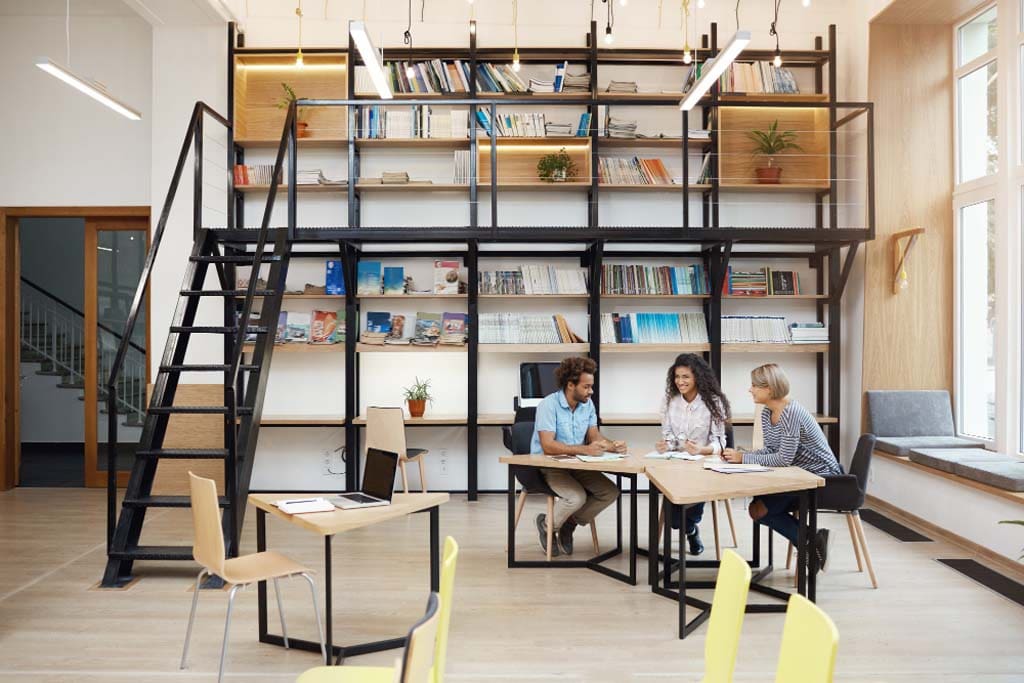Stamford’s fast-paced business environment is driving companies to rethink how work gets done—and where it happens. As collaboration becomes central to innovation, office furniture is no longer just about desks and chairs; it’s about creating environments that fuel connection, flexibility, and productivity. The shift toward collaborative office spaces reflects a deeper need for thoughtful design that supports both individual focus and dynamic team interactions.
Here are five essential insights every Stamford business owner should know about investing in collaborative office furniture.
Key Takeaways✓ Collaborative office spaces boost teamwork, creativity, and overall productivity. ✓ Flexible workspaces for teams adapt easily to changing staff sizes and project needs. ✓ Innovative office collaboration areas should support both structured and spontaneous interactions. ✓ Private vs. shared collaborative spaces offer a balance between focus and open communication. ✓ Open-concept office layouts require smart zoning and acoustic planning to stay efficient. ✓ Choosing the right furniture involves comfort, mobility, durability, and tech compatibility. ✓ Even traditional offices can be retrofitted into modern, collaborative environments with the right updates. |
Design trends come and go, but in a collaborative office setting, function always leads. Business owners in Stamford need furniture that looks good and works hard for every square foot. The right pieces support flow, interaction, and focus without forcing teams into rigid setups. Collaborative office spaces thrive on adaptability and comfort, not flashy finishes alone.
Office needs rarely stay the same for long. As teams shift, grow, or adopt hybrid schedules, static setups can quickly become roadblocks. Choosing furniture that can evolve with changing demands helps businesses in Stamford stay ahead. Flexible workspaces for teams start with smart furniture choices that move, adapt, and support multiple uses.
Collaboration shouldn’t come at the cost of concentration. While open-concept office layouts support connection, they can also create distractions. By incorporating the right furniture, companies can offer private vs. shared collaborative spaces that serve different tasks and temperaments.
Furniture should support how people actually work together—not just how they appear in a catalog. Successful collaborative office spaces make room for movement, eye contact, and shared tools. In Stamford’s fast-moving industries, functionality needs to serve interaction without forcing it.

No one-size-fits-all solution works for collaborative furniture. What a creative team needs differs from what an accounting department values. By matching office design to specific work styles, Stamford businesses can maximize both comfort and output.
The global office furniture market size is projected to grow from USD 61.35 billion in 2025 to USD 99.58 billion by 2032—a reflection of how essential thoughtful design has become in the modern workplace. However, selecting the right furniture goes far beyond matching colors and materials.
For Stamford businesses building or updating collaborative office spaces, the focus should be on how well each piece supports flexibility, comfort, and real teamwork. Here are six factors to help narrow down the choices:
Furniture in flexible workspaces for teams needs to adjust as team structures and project needs change. Look for modular seating, foldable tables, and mobile whiteboards that can be reconfigured in minutes. These features allow businesses to create multiple zones within collaborative office spaces—without buying all new furniture down the line.
Not every team works at the same pace or in the same way. Creative departments may benefit from lounge-style seating and low tables, while data teams need ergonomic chairs and clean desk setups. Choosing furniture based on actual daily tasks helps build innovative office collaboration areas that support real-world performance.
Spending 40 hours a week at work adds up quickly, and poor ergonomics can lead to long-term discomfort or even permanent injury. That’s why long meetings and working sessions require more than just a seat—they need support. Comfortable, adjustable chairs and desks can make or break productivity in open-concept office layouts, helping employees stay focused and collaborative without constantly shifting to find a better position.
Today’s collaborative office spaces revolve around tech—from screens to plug-in hubs. Furniture that includes built-in cable management, charging stations, or monitor mounts makes it easier to stay connected without clutter. This is especially important in shared areas where equipment needs to be accessible to everyone.
Furniture should support both private vs. shared collaborative spaces within the same layout. This might include high-back booths, rolling partitions, or acoustic panels that offer some separation without complete isolation. The goal is to allow focused work while still inviting spontaneous conversations and idea sharing.
Quality materials matter—especially in high-use collaborative areas. Tables with reinforced legs, stain-resistant fabrics, and steel-framed chairs stand up better in busy open-concept office layouts. Investing in durable pieces means fewer replacements and more consistent experiences across flexible workspaces for teams.

Transforming a traditional office into a space that supports collaboration doesn’t mean tearing everything down. Stamford business owners can keep the core structure of their offices and still create a modern environment that encourages teamwork and flexibility. With a few strategic updates, even the most formal layout can evolve into a hub for collaborative office spaces and flexible workspaces for teams.
Begin by identifying unused or underused areas that could serve as shared zones. Opening up sections of the office—even small ones—can make room for collaborative office spaces that feel inviting rather than forced. Keep some structure but shift the layout to better support open-concept office layouts.
Replace rigid desk rows with mobile tables, benches, or nesting desks. Modular furniture supports flexible workspaces for teams by allowing them to regroup or separate as projects evolve. It also helps repurpose areas for both daily work and spontaneous meetings.
Add a few key pieces designed specifically for group interaction—like standing-height tables, writable surfaces, or lounge seating with shared tech access. These anchor points create innovative office collaboration areas that invite interaction without formal scheduling. Teams naturally gravitate toward them when they need to brainstorm or regroup.
Create a mix of open and semi-enclosed areas so employees can choose where and how they work. Furniture like acoustic pods, screen dividers, or enclosed booths offers privacy without cutting people off. This balance allows businesses to accommodate private vs. shared collaborative spaces in one cohesive environment.
Traditional offices often lack the acoustic balance needed for open collaboration. Adding sound-absorbing panels, rugs, or soft wall textures can reduce noise in open-concept office layouts. Paired with warm, layered lighting, these updates make collaborative zones feel more relaxed and functional.
Not everything needs to be replaced. Keeping a few traditional desks, executive offices, or quiet rooms provides options for tasks that still require solitude. Combining old with new helps employees transition smoothly into flexible workspaces for teams without losing their sense of stability.
As you retrofit your office for collaboration, don’t overlook opportunities to embed your company’s identity into the environment. Custom wall graphics, branded color accents, and furniture that reflects your organizational values can make shared spaces feel uniquely yours. Incorporating elements that highlight company culture—like mission statements, team achievements, or local artwork—helps foster a sense of belonging and reinforces the purpose behind the workspace transformation.

Open-concept office layouts are known for breaking down walls—literally and figuratively—but they can also introduce distractions if not managed well. Stamford businesses embracing this setup need to create a space that encourages teamwork without sacrificing individual focus. With the right strategies and thoughtful design, it’s possible to maintain high productivity in collaborative office spaces that feel open, welcoming, and efficient.
Use rugs, lighting, furniture groupings, or color accents to break up the space. These subtle cues help employees understand where quiet work ends and where collaborative office spaces begin. In open-concept office layouts, even visual boundaries can boost focus without isolating anyone.
Shared screens, printers, whiteboards, and charging stations should be placed within easy reach. Disorganized or poorly placed tools waste time and reduce flow in innovative office collaboration areas. A tidy, tech-friendly environment supports both teamwork and efficiency.
Spontaneity has its place, but structure helps everyone stay on track. Designate certain times or zones for team meetings to avoid constant interruptions. Even in collaborative office spaces, giving teams rhythm and routine can help balance creativity with consistency.
Allowing teams to adapt their workstations with movable panels, lighting, or seating creates a sense of ownership. In flexible workspaces for teams, comfort and autonomy go a long way in supporting long-term focus. A little personalization can make open-concept office layouts feel more human and less chaotic.
Indoor plants, natural light, and wood textures can significantly enhance both wellness and productivity in open-concept office layouts. Incorporating greenery and natural materials not only improves air quality but also reduces stress and cognitive fatigue. When thoughtfully placed, living walls or potted plants can double as soft partitions, providing both visual interest and subtle privacy between zones.
Lighting plays a major role in maintaining focus and energy levels throughout the day. Open-concept office layouts benefit from layered lighting that includes ambient, task, and accent illumination. Smart lighting systems that adjust based on time of day or activity—like brighter lighting in focus areas and warmer tones in lounge zones—can promote productivity and reduce eye strain.
Durable, easy-to-clean materials like laminate, metal, and high-performance fabrics are ideal for collaborative office spaces. These materials withstand frequent use, especially in flexible workspaces for teams that see daily rearrangements. Look for finishes that resist stains, scuffs, and wear without sacrificing comfort or style.
Yes, many modern pieces are designed to support both in-person and remote collaboration. Mobile workstations, video conferencing pods, and tech-integrated tables allow flexible workspaces for teams to function seamlessly across locations. These setups enhance productivity in both physical and digital collaborative office spaces.
Absolutely—space-efficient options like nesting tables, stackable chairs, and wall-mounted whiteboards are perfect for compact environments. These pieces help create innovative office collaboration areas even in tight layouts. Small businesses can still enjoy the benefits of open-concept office layouts with smart space planning.
Furniture that supports movement, choice, and interaction sends a message that collaboration is valued. Over time, this helps reinforce a team-oriented atmosphere in both open-concept office layouts and private vs. shared collaborative spaces. The physical setup can reflect and shape how people work together.
Yes, many manufacturers now offer sustainable options made from recycled or responsibly sourced materials. These products align with environmentally conscious values while still meeting the demands of flexible workspaces for teams. Eco-friendly choices support healthy, future-forward collaborative office spaces.
Stamford Office Furniture helps businesses in New Haven, CT, bring flexible workspaces for teams to life with high-quality, adaptable furnishings built for real collaboration. From open-concept office layouts to private vs. shared collaborative spaces, our expertly curated solutions support productivity, comfort, and modern team dynamics. Whether upgrading an existing floor plan or building innovative office collaboration areas from scratch, Stamford Office Furniture delivers both style and function that fit the way people actually work.
Browse our collection in New Haven, CT, today and reimagine how your team works together!